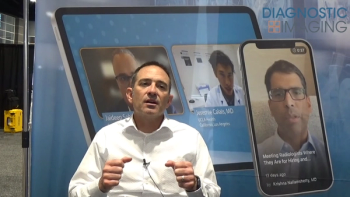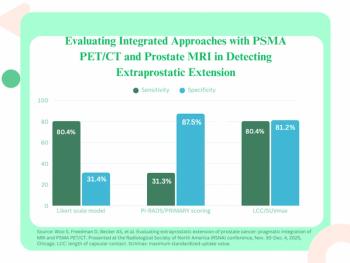
MRI-First Prostate Cancer Screening Strategy Could Be Better, Cost-Effective Approach
Investigators used a hypothetical cohort of men with prostate cancer to test the benefits associated with MRI imaging before biopsy in regard to age-based and risk-stratified screening.
This article was originally published on our sister site
Using MRI as a first-diagnostic pathway could be more cost-effective and could lead to a better benefit-harm profile than opting for a biopsy-first strategy to screen patients for prostate cancer, according to results of a recently published study.
The observed improvements, published in
“This decision analytical model showed that an MRI-first diagnostic pathway was associated with an improved benefit-harm profile for prostate cancer screening compared with a biopsy-first diagnostic pathway,” wrote the investigators. “This improvement was associated with a reduction in biopsies, over-diagnoses, and deaths from prostate cancer. Moreover, an MRI-first approach was associated with more [quality-adjusted life-years] at reduced costs compared with a biopsy-first diagnostic pathway.”
The investigative team analyzed a hypothetical cohort of 4.48 million men in England with a median age of 62 years (range, 55-69). The MRI-first, age-based screening was associated with 0.9% fewer deaths from prostate cancer (1368 men; 95% uncertainty interval [UI], 1370-1409), 14.9% fewer over-diagnoses (12,370 men; 95% UI, 11,100-13,670), and 33.8% fewer biopsies (650,500 men; 95% UI, 463,200-907,000) when compared with biopsy-first age-based screening.
More, there was an association of MRI-first, risk-stratified screening and between 10.4% (7335 men; 95% UI, 6630-8098) and 72.6% (51,250 men; 95% UI, 46 0,70-56,890) fewer over-diagnosed cancers using 10-year absolute risk thresholds of 2% and 10%, respectively.
When compared with MRI-first, age-based screening, there was between 21.7% fewer MRIs (412,100 men; 95% UI, 411,400-412,900) and 53.5% fewer biopsies (1,016,000 men; 95% UI, 1,010,000-1,022,000) with these same risk thresholds, respectively.
MRI-first, risk-stratified screening at thresholds of 8.5% and 7.5% were the most cost-effective strategies when analyzed at willingness-to-pay thresholds of $26,000 and $39,000 per quality-adjusted life-year gained, respectively.
“In this decision analytical model of a hypothetical cohort of 4.48 million men aged 55 to 69 years, MRI-first screening strategies were associated with a more favorable benefit-harm profile and with improved cost-effectiveness compared with biopsy-first strategies,” wrote the investigators. “The MRI-first risk-stratified screening strategies were more cost-effective than MRI-first age-based screening and were associated with less over-diagnosis and a comparable number of prevented deaths from prostate cancer.”
The primary measures of the research were benefit-harm profile and cost-effectiveness. The analytical model utilized a life-table approach, with research conducted between December 2019 and July 2020.
The team of investigators suggest that there are no comparable models of prostate cancer that incorporate MRI and no MRI-first screening trials. More, instead of making educated assumptions on the association between polygenic risk and indolent and non-indolent cancers, the investigators incorporated age-specific probabilities of overdiagnosis.
As for the limitations, a major limiting factor centered around distinguishing between clinically significant and insignificant cancers. The research team explained that the proportion of cancers that progress from insignificant to clinically significant is unknown. More, the research team is also unsure of the “implications of an MRI-first diagnostic pathway for long-term prostate cancer outcomes.”
Reference:
Callender T, Emberton M, Morris S, et al. Benefit, Harm, and Cost-effectiveness Associated With Magnetic Resonance Imaging Before Biopsy in Age-based and Risk-stratified Screening for Prostate Cancer. JAMA Network Open. 2021;4(3):e2037657. doi:10.1001/jamanetworkopen.2020.37657
Newsletter
Stay at the forefront of radiology with the Diagnostic Imaging newsletter, delivering the latest news, clinical insights, and imaging advancements for today’s radiologists.




























